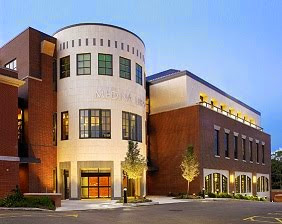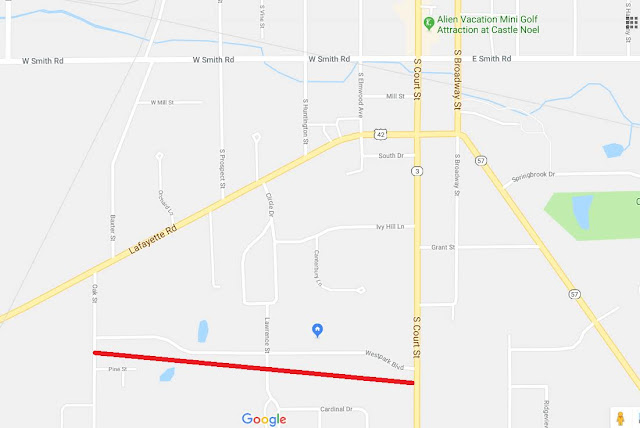 |
| Entrance to the Medina County Career Center (MCCC). |
Every fall hundreds of Medina County High School students head off to classes at the Medina County Career Center in pursuit of educational training.
How many of them pass by or enter the OC Duke Agricultural Building without knowing anything about the man the building is named for?
 |
| Sign outside the O.C. Duke Building |
 |
| The O.C. Duke Building at the MCCC. |
Wild Life Center at the OC Duke agricultural Center at MCCC December 4, 2015 Cleveland
O.C. Duke, or more formally, Orland Charles Duke, was born in 1901 in West Virginia to John F. And Nellie (Daniell) Duke. He was the second son of the farming couple. He graduated high school and attended college in Kentucky for a year before following his brother to Ohio State University in Columbus.
"O.C." as he was most often known, studied agricultural science and thrived at OSU! He was a founding member of the Tau Gamma Phi agricultural fraternity, which later became Alpha Gamma Sigma.
TGF
 |
The "Makio" yearbook was created by O.C. Duke especially for the OSU students that graduated in December.
Upon graduation, Duke was hired by the Medina City School Systems. His 1925 OSU graduation picture is the same one used for the 1925 Medina High School Yearbook.
 |
| 1925 Medina High School Yearbook |
In 1927, O.C. married his wife, Lauraette, in 1927, and they soon settled down in their East Friendship home and started their family, son Ronald, and daughter Marilyn.
O.C. was a man of action and took on many responsibilities, besides teaching. Among his accomplishments are:
O.C. was a man of action and took on many responsibilities, besides teaching. Among his accomplishments are:
- Started teaching in Medina in 1925. MHS had the only agricultural curriculum in the county. Important in a then predominately farming community. He was the only AG teacher until 1950.
- Taught Vocational Agriculture at Medina High School for 42 years – till 1968. Nicknamed “Mr. Agriculture” His classes featured:
- Frequent field trips
- 10-day summer excursions to Canada, the State Fair and New York City.
- Opened up the local chapter of Future Farmers of America (FFA) to girls long before the national organization did.
 |
| 1965 Medina High School Yearbook |
- Served Adults & young farmers in the area. Started a farmer’s club
- Promoted the welfare & social activities of farmers and city dwellers with his involvement in:
- Medina County Farm Bureau
- Medina County Agricultural Society
- Medina County Extension Service
- Agricultural Stabilization Committee
- Medina County Fair Board – 50 years
- Izaak Walton League
- Montville Grange
- 4-H Extension Advisory Committee member
- 4-H Club adviser
- Cleveland Farmers Club
- Medina County Park System
- Medina City Uptown Park – promoted the building of the Gazebo that is a city landmark today. Weeded flower beds.
 |
| O.C. Duke presenting an award to Joy Anderson, the first young woman to receive the State FFA degree. Medina Gazette 23 April 1975 page 13. |
- Advocated for the development of the Medina County Joint Vocational School District – now the Medina County Career Center.
- His 100th birthday party thrown by the Medina Kiwanis Club in 2001. He was then the oldest active Kiwanian in the world. He was a member for 75 years!
- Long after his retirement, he was a resource for people as he fielded their questions.
- At his East Friendship home, he kept bees, raised chickens planted fruit trees
- Wrote a column for the Medina Trading Post & Mid-Ohio Farmer magazine.
 |
| O.C. in front of the building that carries his name with two unknown people. Photo on FindAGrave. |
O.C.'s many accomplishments did not go unnoticed. Throughout his long career, he received many, many awards, some of which are listed here:
- Bob Drake Award (Former Plain Dealer Farm writer) 1965
- John T. Tobin Award from Izaak Walton League – 1978, 3rd in country to receive it.
- Building named in his honor in 1980 Was at the rededication after renovation in 2000.
- Scholarship presented to an agricultural student each year in his honor.
- In 1981 awarded the OSU Alumni Association Citizenship Award in honor of his community service.
- 1984 named of the Ohio Senior Citizens Hall of Fame.
- Medina High School Hall of Fame 2001
- Medina Chamber of Commerce Hall of Fame
- Awarded the George F. Hixon Fellowship Award from the Kiwanis
“I attribute my long life to good DNA. I didn’t drink, I didn’t smoke and I didn’t run around with the wrong kind of women.” on the occasion of his 100th birthday
And my favorite:
And my favorite:
“Don’t judge people, love everyone, and it's all about helping people the best you can.” on the occasion of his 100th birthday.
 |
| From OC's obituary in the Medina Sun, 16 May 2002, page B3. |
SOURCES:
- Boyer, Sam,“O.C. has a hundred years of memories to share”, The Medina Sun, 23 August 2001, page A 3.
- “Duke’s long, active life comes to an end’, The Medina Sun, 16 May 2002, page B3.
- Gladden, John, “’Mr. Agriculture’ dies at 100”, The Medina Gazette, 14 May 2002, page A-2.
- “’Historymaker’ O.C. Duke third in nation to get award” Medina Gazette, 18 May 1978, page 2.
- The Medina Gazette 23 April 1975 page 13.
- “Orland C. Duke”, The Medina Gazette, 15 May 2002, page A-2.
 |
| While taking photos at the O C Duke Agriculture Building, this Monarch butterfly stopped by. |








































